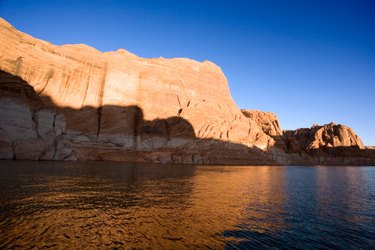
Sandstone is classified as a sedimentary rock. It is made of some of the most common minerals found on earth, which gives sandstone a significant footprint around the world. Some interesting characteristics of sandstone relate to its composition, origin, type and use.
Composition
Video of the Day
Sandstone is composed of very small grains of minerals or rocks, usually the size of grains of sand. Individual grains normally range in size between .00394 and .07874 inches. The most common minerals found in sandstone are feldspar and quartz. Sandstone takes on the color of the materials it contains. The most common colors are brown, yellow, red, white, gray and tan, with yellow and tan predominating.
Video of the Day
Origin
Sandstone is of clastic, as opposed to organic or chemical, origin. Sandstone is formed in two steps. First, sand layers accumulate into piles known as grus. Water or air sorts the grains of rock or minerals in these piles, and sedimentation occurs. The pressure of deposits lying over the rock or mineral grains then compacts them, and materials such as clay, calcium carbonate or silica precipitate through the sediment layer and cement the rock or mineral grains together.
Types of Sandstone
The environment where sandstone components are deposited determines the nature of sandstone. The size of component grains of rock or minerals, how the grains are sorted and the structure of the sediment formed are some of the determinant environmental factors. Sandstone environments include lake, alluvial fan, river, glacial outwash, desert, river delta, submarine channel, storm deposit, offshore bar and sand wave and tidal delta environments. Sandstones are divided into three large groups: arkosic sandstones that are composed mostly of granite; quartzose sandstones, or beach sand, that are made up of mostly quartz; and argillaceous sandstones that have a lot of clay or silt.
Uses of Sandstone
Some sandstone is easy to work with, even though it resists weathering. For this reason, sandstone is often used as a building or paving material. Sandstone is also used to make grindstones and stones for gristmills. Sandstone formations are useful as aquifers. Since sandstone is porous, water filters through it, and large quantities of water can be stored in sandstone formations. The filtering process is useful in removing pollutants from the water.